Related Research Articles

A voivodeship is the highest-level administrative subdivision of Poland, corresponding to a "province" in many other countries. The term has been in use since the 14th century, and is commonly translated in English as "province" or "state".
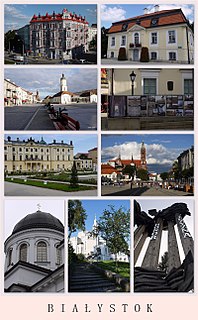
Białystok is the largest city in northeastern Poland and the capital of the Podlaskie Voivodeship. Białystok is the tenth-largest city in Poland, second in terms of population density, and thirteenth in area.
A voivodeship is the area administered by a voivode (Governor) in several countries of central and eastern Europe. Voivodeships have existed since medieval times and the area of extent of voivodeship resembles that of a duchy in western medieval states, much as the title of voivode was equivalent to that of a duke. Other roughly equivalent titles and areas in medieval Eastern Europe included ban and banate.

Bielsk Podlaski(

Drohiczyn is a town in Siemiatycze County, Podlaskie Voivodeship, Poland. The town has a population of 2,110 and is situated on the bank of the Bug River. Drohiczyn has a long and rich history, as in the past it was one of the most important cities of the region of Podlachia. Currently, it is the seat of Roman Catholic Diocese of Drohiczyn.
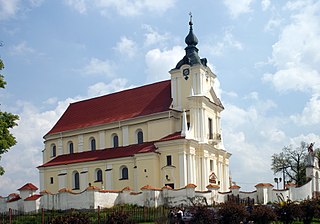
Siemiatycze is a town in eastern Poland, with 15,209 inhabitants (2004). It is situated in the Podlaskie Voivodeship ; previously it was in Białystok Voivodeship (1975–98). It is the capital of Siemiatycze County.

Podlachia or Podlasie, is a historical region in the eastern part of Poland. Between 1513 and 1795 it was a voivodeship with the capital in Drohiczyn. Now the part north of the Bug River is included in the modern Podlaskie Voivodeship with the capital in Białystok.

Volhynian Voivodeship was a unit of administrative division and local government in the Grand Duchy of Lithuania from 1566 until 1569 and of the Polish Crown within the Polish–Lithuanian Commonwealth from the 1569 Union of Lublin until the Third Partition of Poland in 1795. It was part of the Ruthenian lands in the Lesser Poland Province.

Skorupy is one of the districts of the Polish city of Białystok, located in the eastern part of the city and contains industrial and residential buildings.

The Kiev Voivodeship was a unit of administrative division and local government in the Grand Duchy of Lithuania from 1471 until 1569 and of the Crown of the Kingdom of Poland from 1569 until 1793, as part of Lesser Poland Province of the Polish Crown.

Mielnik is a village in Siemiatycze County, Podlaskie Voivodeship, in north-eastern Poland, close to the border with Belarus. It is the seat of the gmina called Gmina Mielnik. It lies approximately 17 kilometres (11 mi) south-east of Siemiatycze and 88 km (55 mi) south of the regional capital Białystok.

Subdivisions of the Polish–Lithuanian Commonwealth evolved over many centuries from the fragmentation of the Piast dynasty to the union of Poland and Lithuania.
Voivodes of the Polish–Lithuanian Commonwealth were one of the highest ranking officials who could sit in the Senate of Poland. They were the officials in charge of the voivodeships (provinces/palatinates) of the Polish–Lithuanian Commonwealth. The office first appears as Palatine (Palatinus) who held the foremost position after the King. As Poland broke up into separate principalities, each Prince had his court and his own Palatine. When the Kingdom was consolidated, the Palatines became heads of those former Principalities, which then became Palatinates. As such, the Palatines were members of the King's Council. The title merged with the Polish Voivode or Wojewoda. The difference between Voivode and Duke is that whereas the Duke began as a rank by appointment of the Monarch and later became a hereditary title of honour, the Voivode was appointed for life and maintained real authority as an official—before the Voivodes, too, lost significance to the Starostas. Polish historians, however, use Palatine (Palatyn) and Voivode (Wojewoda) synonymously.
Ziemia is a historical unit of administration in Poland and Ruthenia.
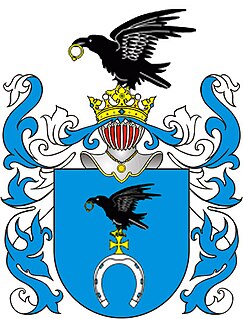
Skwierczyńskiof Ślepowron is the surname of a Polish szlachta (nobility) family from Podlaskie. The knight family came to the parish of Paprotnia in the area of Drohiczyn most likely from Masovia during the settlement led by Janusz I of Warsaw in the second half of the 14th century, or when PodlaskieUn transferred under the Lithuanian rule of Vytautas in 1405, who continued the settlement of Polish knights from areas of Masovia, as well as Łęczyca Voivodeship and Kuyavia in Podlaskie which had been deserted by the invasions of the Teutonic Knightss and Yotvingianss.
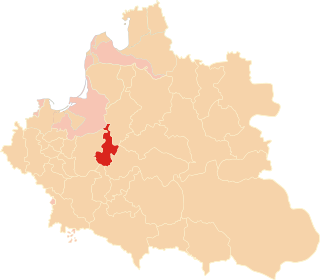
The Podlaskie Voivodeship was formed in 1513 by Sigismund I the Old as a voivodeship in the Grand Duchy of Lithuania, from a split off part of the Trakai Voivodeship. After Lithuania's union with the Kingdom of Poland in 1569 and formation of the Polish–Lithuanian Commonwealth, the voivodeship was transferred to the Polish Crown, where it belonged to the Lesser Poland Province of the Polish Crown.

Podlaskie Voivodeship or Podlasie Province is a voivodeship (province) in northeastern Poland. It borders on Masovian Voivodeship to the west, Warmian-Masurian Voivodeship to the northwest, Lublin Voivodeship to the south, the Belarusian Voblasts of Grodno and Brest to the east, the Lithuanian Counties of Alytus and Marijampolė to the northeast, and the Kaliningrad Oblast of Russia to the north.
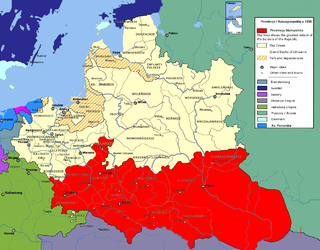
Lesser Poland Province was an administrative division of the Crown of the Kingdom of Poland from 1569 until 1795 and the biggest province of the Polish-Lithuanian Commonwealth. The name of the province comes from historic land of Lesser Poland. The name of the province did not imply its size, but rather seniority.
Podlaskie is the land of the confluence of cultures – Polish, Belarusian, Ukrainian and Lithuanian – and is indicative of the ethnic territories limits. Eastward of Podlaskie lie ethnically non-Polish lands, while westward ethnically non-West Ruthenian and non-Lithuanian lands too. Today, mainly Polish and Ruthenian is spoken in Podlaskie, while Lithuanian is preserved by the small but compact Lithuanian minority concentrated in the Sejny County.
Bielsk Land, was an administrative unit (ziemia) of the Grand Duchy of Lithuania, Kingdom of Poland and the Polish-Lithuanian Commonwealth. Created in 1413, it originally belonged to the Lithuanian Trakai Voivodeship. In 1513, it became part of newly created Podlasie Voivodeship, and from 1569 until 1795, it belonged to the Kingdom of Poland.